I first saw this film in a late night television slot in the 1970s. It was made by Norman Cohen in 1968, but rather than presenting yet another montage of ‘swinging’ London and Carnaby Street, his film seemed to capture an older, grimier London, albeit one that was fast-disappearing. I spent my childhood in Wales, but I always felt a strong spatial affinity with London. My parents had lived in the city until just before my birth and I was brought up on tales of life in London, an almost mythical city, or so it seemed to me. Fed by these tales, London grew and solidified in my imagination.
My parents had lived in Chelsea, on the top floor of a rather grand house in Eaton Square. Dad was a painter and decorator for a brewery and Mum cooked and cleaned for the elderly spinster who owned the house and lived alone in faded gentility. From rural Wales my childhood imagination was fired by stories of the street characters of 1950s Chelsea. Dad would often talk, for instance, of the bare-chested, kilted Scotsman who would march proudly up the King’s Road each day only to stumble back home later with a belly full of beer.
The London of that time was a city of smoke, smog and post-war austerity. It was afflicted with a severe housing crisis and, in my parents’ part of the city, squatting was a widespread response. There was still rationing in the 1950s and, even at the time of Cohen’s film ten years later, the people in the streets still looked shabby and pinched. It was only when I watched this film again to review it that I realised it was filmed in colour; in my memory it existed in tones of grey.
The London Nobody Knows is a film based on the 1962 book of the same name by Geoffrey Fletcher, who also scripted the movie. Cohen employs the smoothly patrician James Mason, dressed as if on his way to a country weekend, to be our guide and narrator. His somewhat archaic narration adds to the general Victorian atmosphere of this portrait of a city.
Cohen’s camera captures images of meths drinkers, feral kids, buskers, pie and mash shops and Victorian sewers. So much of what we see is gone: the faded shell of an old music hall in Camden now sadly lost, unlicensed street performers, pubs and greasy-spoon caffs. Indeed, so much of the London shown in this film is now just a memory, swallowed up by global commercial homogeneity.
This is not picture-postcard London, it is a meander through the fetid underbelly of the city which, almost while the camera rolled, was disappearing under a swathe of concrete. The script leaves us in no doubt that this was not to Geoffrey Fletcher’s taste. The soundtrack too matches the odd, curmudgeonly mood of the film: discordant plinks and cymbal crashes give some sequences, such as the montage from the pie, mash and eel shop, a decidedly surreal air.
Meanwhile, resplendent in tweed jacket and flat cap, prodding into corners with his furled umbrella, James Mason strides from one grimy location to the next. He talks awkwardly with homeless people near a night shelter and kicks despondently at rubble on the floor of the condemned Bedford Theatre. But perhaps the most enjoyable sequence is when he visits a Victorian gents toilet in Holborn, complete with goldfish in the glass cisterns:
‘here, one might say, one finds the only true democracy because all men are equal in the eyes of the lavatory attendant’.
The London Nobody Knows is an enjoyably bizarre film. It’s also a time-capsule of half-forgotten images and a reminder of a London that existed somewhere between the Victorian era and post-modernism. This is the London of my parents. Or, perhaps more correctly, the London their tales created in my imagination. Watching it makes me feel a nostalgia for something which maybe never quite existed. They don’t make psychogeography like this anymore.

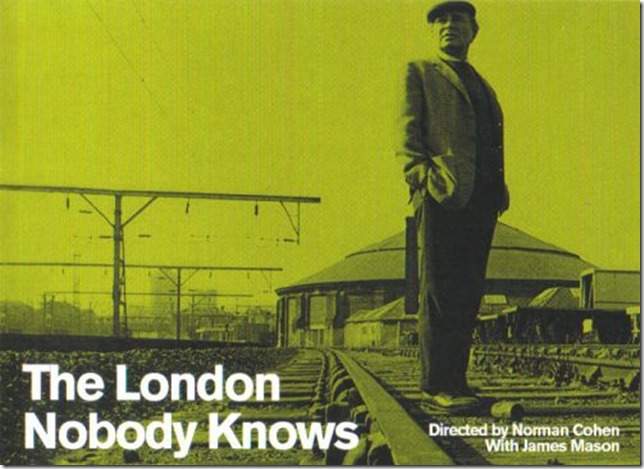
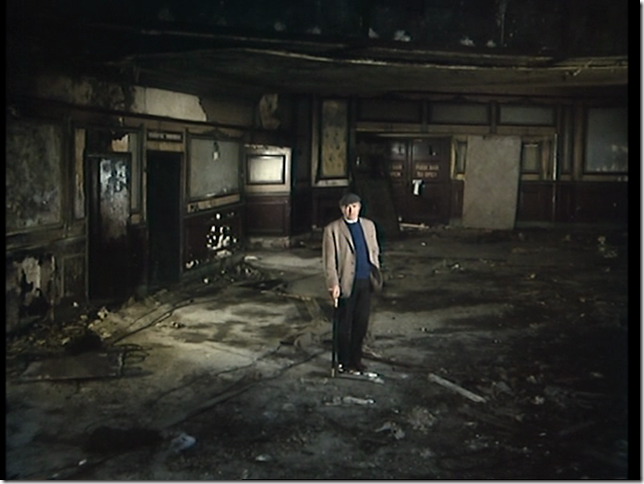
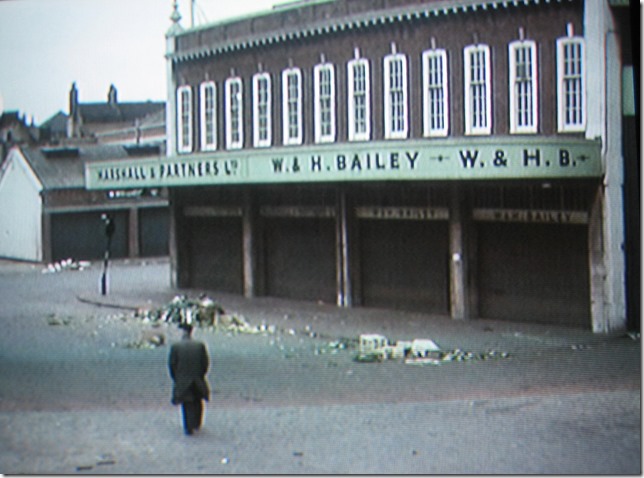
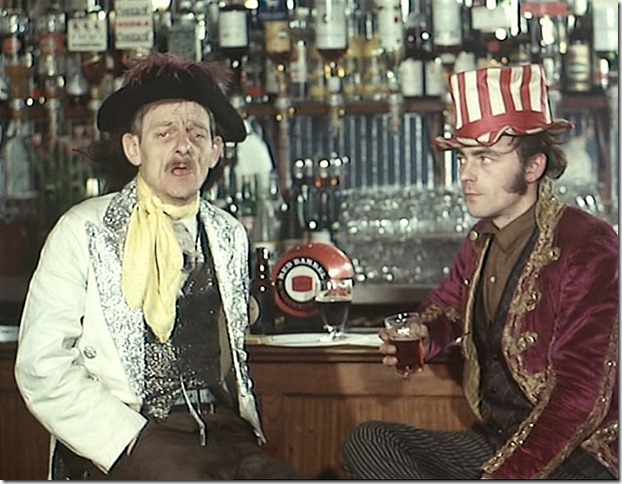
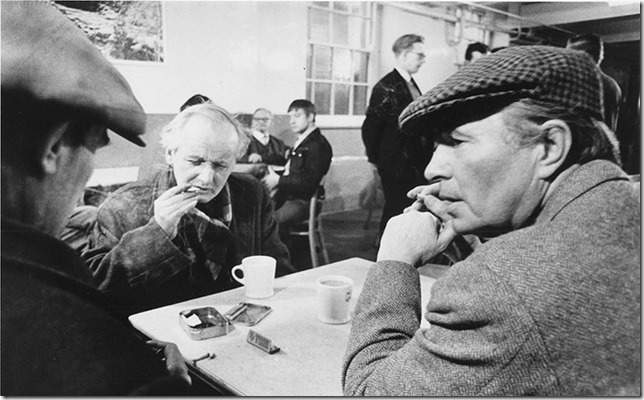
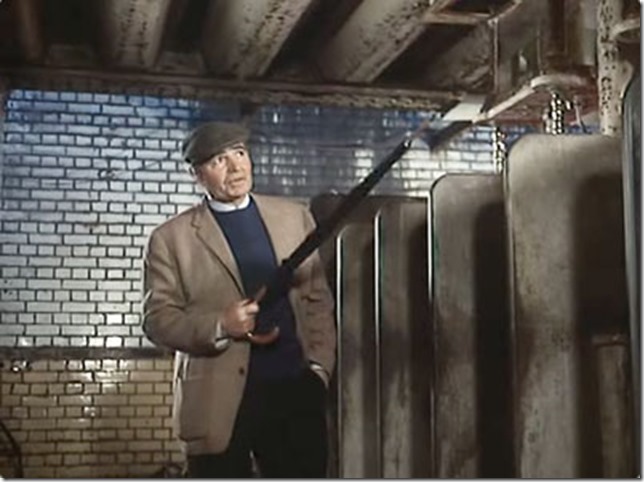
Excellent post Bobby. I’ve not seen the film but the appetite has certainly been whetted. Also like how your personal and imagined memories interlace the review. Funnily enough I think Mrs F has the book. Must dig it out.
Cheers! I have to confess I’ve not read the book, but there was an interesting Radio 4 documentary last year where Dan Cruickshank went back to some of the places Fletcher wrote about. Just checked and it’s still available on iPlayer! One unfortunate (some would say) legacy of my family background is that it’s left me as a Chelsea supporter…
http://www.bbc.co.uk/iplayer/episode/b00sxj2l/The_London_Nobody_Knows_Episode_1/
A friend recently bought me the book as a present but I haven’t seen the film. Excellent post and so true this is a portrait of London that only exists in the memory. From a place of working people to a super city for the super rich. I know which I prefer.
What’s fascinating about the film (and I imagine the book) is that it shows a London which people of an older generation will still remember, but it is a past which is, to use LP Hartley’s phrase, ‘a foreign country’.
Thanks for this – hadn’t heard of the film and now it’s on my Must Watch list. This is London into which I was born, but knew so little about.
Thanks – I’ll lend you the DVD the next time I see you.
There was a clip of the music hall section of the film showing at the Ruins exhibition at the Tate, which I found very moving. Thanks for reminder to watch whole thing. I did have a Geoffrey Fletcher book at one time but not this one. I found his drawings very old fashioned at the time (maybe I can appreciate them more now!) but he did make a good record of many now lost bits of London. The City of London has a big collection of his work but strangely not much on London. http://collage.cityoflondon.gov.uk/collage/app?service=external/SearchResults&sp=M35217%3AT%3AT%3AT
Thanks for the comments and the interesting link, Diana. I think the music hall section of the film is a good choice for the Ruins exhibition. James Mason is a national treasure too!
Hello Bobby,
Do you know what the very plaintive song is being sung near the end of the film?
Hi Julian. You mean the guy in the Homburg hat in Fournier Street, just after the sequence with the kids? I don’t know the song I’m afraid, but it sounds like it might be an old Yiddish song. Nothing in the closing credits either.
I worked from 1969 to 1975 at a firm of patent & trade mark agents in Holborn and well remember the urinal with the glass cistern full of goldfish.
This is another urinal of Victorian origin I remember in the same area from walking often from the firm I worked for in Lincoln’s Inn Fields to the Patent Office in Chancery Lane: https://www.flickr.com/photos/dixon1919/4982315611/
The whole area east of Tottenham Court Road is full interesting history and architecture.
Thanks Philip, great picture. Good to see places like this still survive.
The old Bedford music hall was immortalised by Walter Sickert’s paintings
Thanks Michael, I didn’t know that – just found a lot about the Bedford his other music hall work on the V & A website